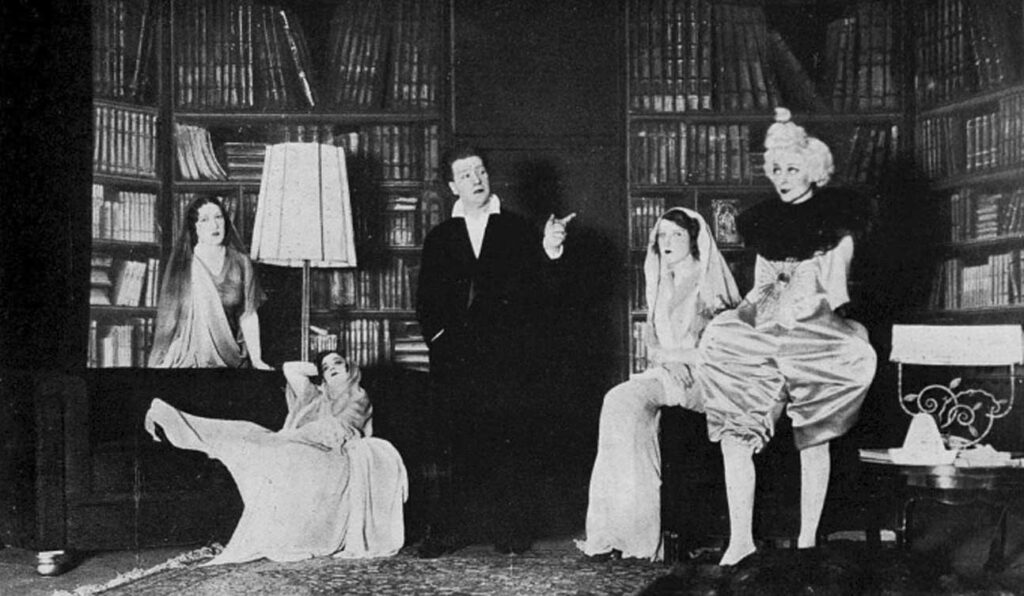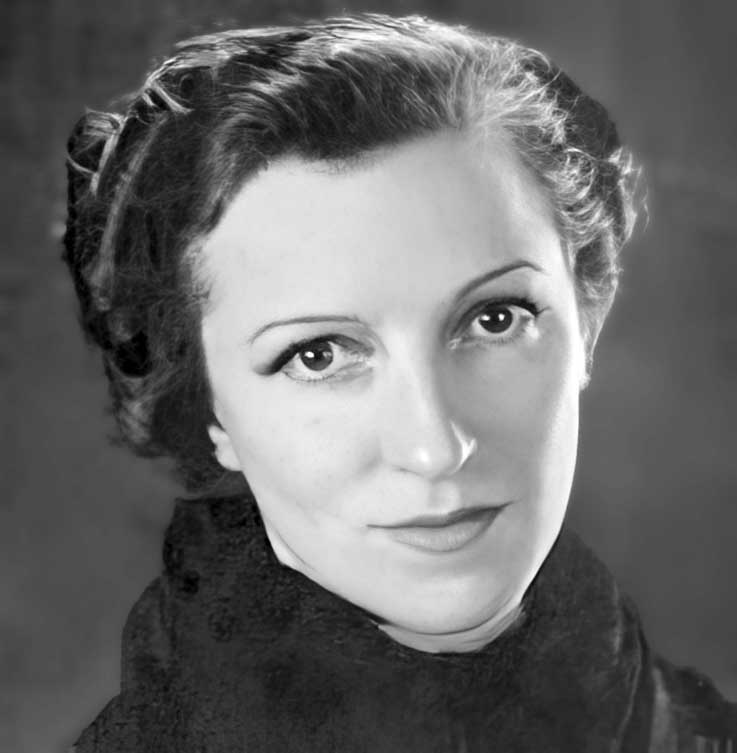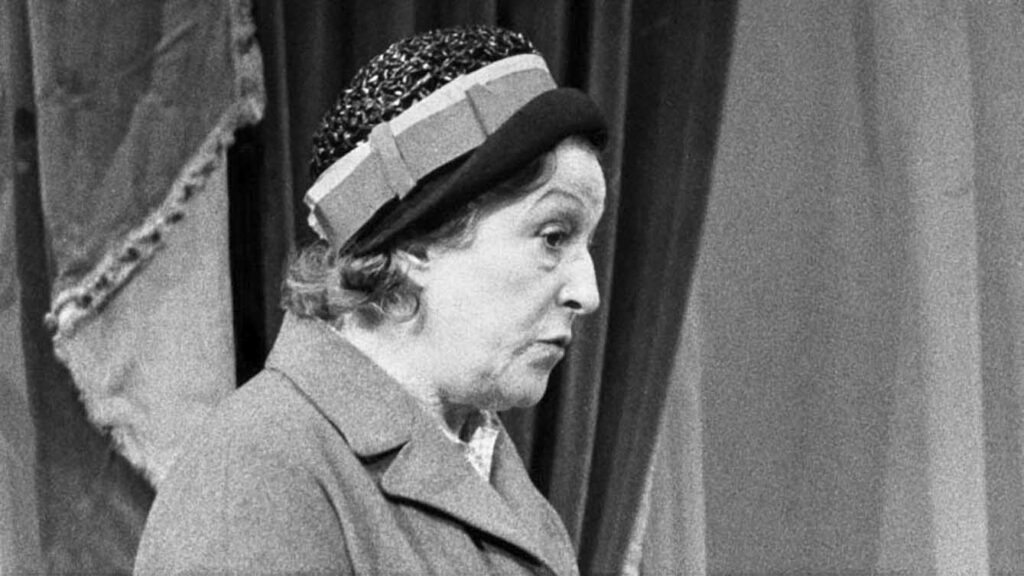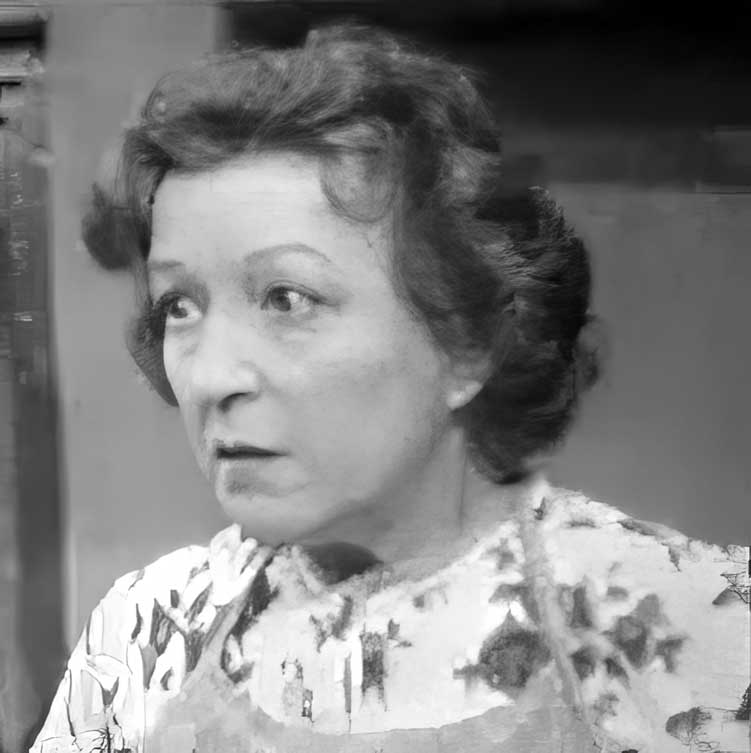Information
Full name: Noëla Flips
Birth: December 23, 1899 in Château-Chinon, France
Death: November 29, 1984 in Paris, France
Marriages:
Raoul Paul Arnold Pignol (June, 26, 1928 – February 7, 1938)
Léon André Pignol (March 18, 1943 – May 28, 1962)
Job on Snow White:
Voice of the hag in the second French version

Miss Flips at the theater
Born two days before Christmas in 1899 in Château-Chinon to a father who worked as an architectural clerk and a stay-at-home mother—whose first name she would later adopt as her stage name—Noëla Flips would become “Mary Francey,” and later “Marie Francey,” a name that sounds like “Français” (French).
She appears to have been part of the Odéon Theatre company in the 1920s.
On August 13, 1927, “the charming Mary Francey” played Ophelia in Hamlet, performed at the Popes’ Palace in Avignon. On August 23, she performed in Petrarch and Laura by Mme François Vaucienne at the same venue, in front of Édouard Daladier (then a Minister, later head of the government), alongside actor Raoul-Henry.
In January 1928, the name “Marie Francey” appeared for the first time in an article in Comœdia, reporting on the performance of the play La ruée vers l’amour, with Albert Lambert and Raoul-Henry. Six months later, Marie married the latter.
When she married Raoul Pignol, a stage actor known by the pseudonym Raoul Henry (his mother’s name), she was living at 6 Rue du Laos, a luxurious address near the Eiffel Tower, and was already listed as an “actress” on official documents. It’s unclear how happy their marriage was over time, but Marie frequently shared the stage with her husband in the following years.
For instance, in September 1928, he played Dr. Jean Monray and “Mary Francey” portrayed Cécile Desbiens in Le mortel baiser by Loïc Le Gouriadec at the Alhambra in Lille.
On April 20, 1929, she performed Oreste by René Berton at the ancient theater in Cherchell, Algeria, alongside Raoul Henry. She then returned to the stage with him on August 11, 1929, in Impéria at the Roman arena in Saintes. She was introduced as a member of the Théâtre de l’Œuvre company. On October 9, at the Gymnase Theater in Marseille, she performed in Prise, once again with Raoul.
In the winter of 1928-1929, she and Raoul followed the Jean Hervé company on a tour of Egypt.
In October 1930, she appeared at the Théâtre de la Madeleine in the role of Sacha Guitry’s conscience in One night, When You’re Alone, and in Le veilleur de nuit, also by Guitry. In October 1931, she played “La femme sans Voile” at the Variétés in Marseille.
On August 9, she returned to Saintes to perform in Penthesilée by Alfred Mortier, again with Raoul Henry. In March 1932, she rejoined Guitry for Le voyage Tchang-Li; les desseins de la providence at the Théâtre de la Madeleine, where she played a nun.
Still working with Guitry, she could also be heard on the radio in the role of La Guimard in a musical comedy titled Mozart on November 15, 1935. She also performed with him in Despote et Grand Seigneur.
The Voice of the Stars
The arrival of talking pictures quickly gave her the opportunity to specialize in a field where she truly excelled: dubbing—a technique used since the early days of cinema but one that only became technically refined around 1933. Marie soon began voicing leading roles of strong-willed women and quickly became the official French voice of Marlene Dietrich, Claudette Colbert, Barbara Stanwyck, and Carole Lombard.
She was first mentioned in the film magazine Pour Vous in September 1934, in a review of The Scarlet Empress, regarding Marlene Dietrich:
“She is excellently dubbed by Mlle Marie Francey, who has nearly replicated her intonations, and whose voice harmonizes perfectly with the image of Marlene Dietrich; the pronunciation of certain toneless phrases is flawless.”
Praising articles about this same performance also appeared in L’Information Financière, Économique et Politique.
In L’Œuvre on November 23, 1934, a review of Cleopatra states:
“A consummate artist, Mlle Marie Francey—whose face we do not know—lends her voice to the image of Claudette Colbert with a talent that had already stood out in The Scarlet Empress.”
On June 20, 1935, Pour Vous mentioned her again for the release of The Devil Is a Woman, referring to her as the actress “who usually dubs” Marlene Dietrich and publishes her portrait on September 12, 1935.
L’Œuvre on October 24, 1935, reports that she dubbed The Crusades by Cecil B. DeMille, alongside Richard Francoeur.
The reviewer for L’Excelsior, in the May 8, 1936 issue, attempted a comparison between the original and dubbed versions of Desire starring Marlene Dietrich, and concluded:
“We were able to appreciate the quality of the dubbing, where everything—even Marlene’s voice—thanks to Mme Marie Francey, seemed like the star’s own: muted and monotone, yet compelling.”
This opinion was shared… by Marlene Dietrich herself. During a visit to the Paramount studios in Paris, she saw her film in its dubbed version and “was thrilled with how Marie Francey had dubbed her voice.”
She is quoted as saying:
“It’s really excellent,” she said upon leaving the screening room. “I’m stunned… It’s extraordinary how Mlle Francey—whose voice truly resembles mine—captured my inflections, even down to my faintest whispers! As an artist, I used to consider dubbing almost heretical. When I came to see my film dubbed, I must admit, I felt a bit apprehensive. I was wrong. I can honestly say I am not disappointed in the least.”
For any performer, there could be no higher compliment. The anecdote was later summarized in Le Matin on July 31 and in La Liberté on August 1, 1936.
L’Intransigeant, on December 2, 1937, was full of praise for the dubbed version of Angel, calling it a “technical and artistic triumph.”
On December 15, 1937, Natalie Pilenko wrote a full-page article titled In the City of Faceless Voices, in which she observed Richard Francoeur and Marie at work and was “struck by the love they had for their craft.” Of Marie, she wrote:
“She is known to the general public for the flawless way she managed to imitate Marlene’s voice—monotone and unmodulated, and among the most difficult to reproduce.”
An article by Didy Gluntz in Pour Vous on September 12, 1935, was dedicated entirely to her, though she was referred to again as “Mary Francey.”
Her “slender face, delicate smile, and misty gaze” were described in detail.
As dubbing ceased to be a novelty, Marie Francey’s name faded from the press, even though she continued to enjoy a rich and successful career in the field to the point of making the front page of L’intransigeant again on July 20, 1939.


Back to the Stage
Marie divorced Raoul Henry in 1938 and, five years later, married—apparently—a relative of her ex-husband: Léon Pignol. The wedding took place in Sanary-sur-Mer, and they remained married until 1962, just before she recorded the role of the Witch in Snow White.
During the Occupation, Marie seems to have kept a low profile, living in the south of France. She reappeared in 1948, performing under the name Mary Francey alongside Fernand Ledoux in the play Monsieur by Claude Gével in Nice, at the Théâtre du Palais de la Méditerranée. These activities appear to have brought her back to Paris.
She returned to the Paris stage on April 6, 1950, at the Théâtre Montparnasse–Gaston Baty, performing in Jean Anouilh’s Traveller Without Luggage, alongside Maurice Nasil, Michel Vitold, and Héléna Manson.
In 1951, she performed in Ce soir à Samarcande at the Théâtre de la Renaissance with Georges Hubert. Then, starting January 3, 1953, she appeared in La Duchesse d’Algues at the Théâtre Michel. That same year, Sacha Guitry cast her in Palsambleu at the Théâtre des Variétés, which premiered on March 28, 1953.
The following year, she acted alongside Jeanne Boitel in Une femme… des hommes, performed in Nice the week of February 10, 1954.
In November 1955, she could be seen at the Célestins Theater in Lyon playing a duenna in Ruy Blas. In 1957, she portrayed Mémée in Regrets éternels by Constance Coline at the Théâtre de l’Œuvre.
Her dubbing career also shifted during this period toward voicing more mature female characters. Among her leading roles were the voices of Joan Crawford and Bette Davis, including in prestige productions such as All About Eve and Vertigo.
Sacha Guitry also gave her her first screen appearance in 1954, casting her as a lady of the court in Royal Affairs in Versailles. She returned in two small roles in If Paris Were Told to Us in 1956.
Television
It seems that Marie did not appear on television until August 22, 1961, when she played a fishmonger in Les cochons d’Inde, a production that also featured Jean Daurand.
She then played the role of Angelica in Le Cheval Chinois at the Théâtre Charles de Rochefort, a play that was also broadcast on the radio on November 5, 1961.
In 1965, she took to the stage at Paris’s Alhambra theater alongside Bourvil and Annie Cordy in the operetta Ouah-Ouah. In 1969, she performed at the Théâtre Hébertot in Bienheureux les violents, and in 1973 she returned to Le voyageur sans bagage at the Théâtre des Mathurins.
She also appeared in the play Carlos et Marguerite, adapted for the TV program Au théâtre ce soir. She played the servant Léa in the broadcast on May 2, 1969.
On July 8, 1969, she portrayed Rose Ytier in the episode L’auberge de Peyrebeille of the series En votre âme et conscience, which dramatized the 1833 trial of the innkeepers from the hamlet of Peyrebeille, held before the Privas Court of Assizes.
She made one final appearance in the first episode of Un ours pas comme les autres, titled Adieu les roses, which aired on March 10, 1978.


The Witch in Snow White
In the summer of 1962, she was offered the role of the Witch in the new French dubbing of Snow White and the Seven Dwarfs. She elevated the character, terrifying generations of children with her flawless performance that pulled no punches. It would go on to become one of her most iconic roles, alongside that of the alien E.T. in E.T. the Extra-Terrestrial.
I lent my voice to Claudette Colbert, Irene Dunne, Barbara Stanwyck. Carole Lombard was one of the most difficult, because she made faces when she spoke. But you know, after a few sessions, you start picking up even the tiniest quirks of your model.
Marie Francey
